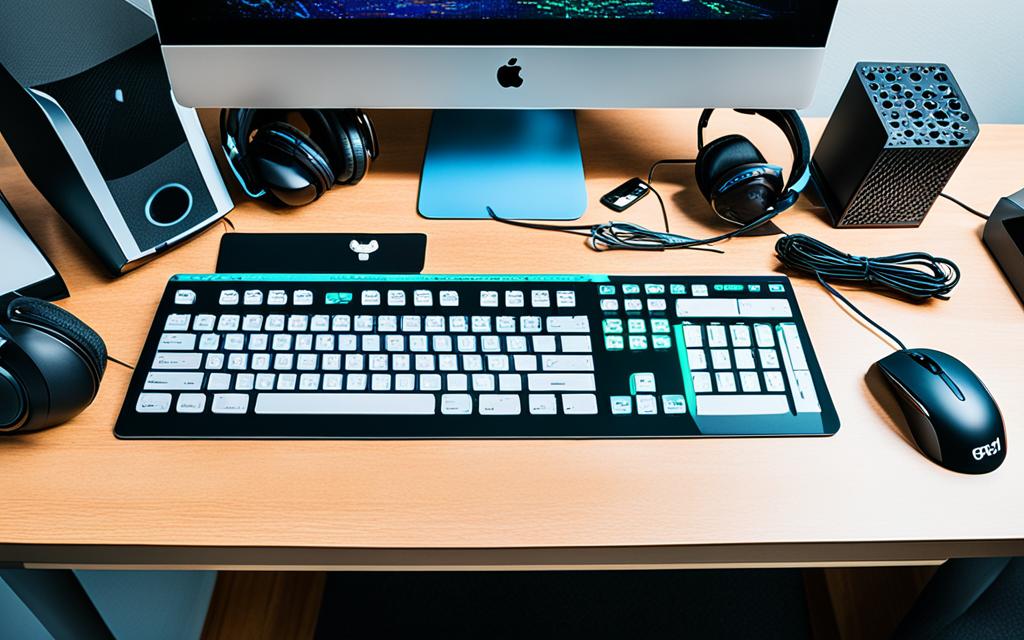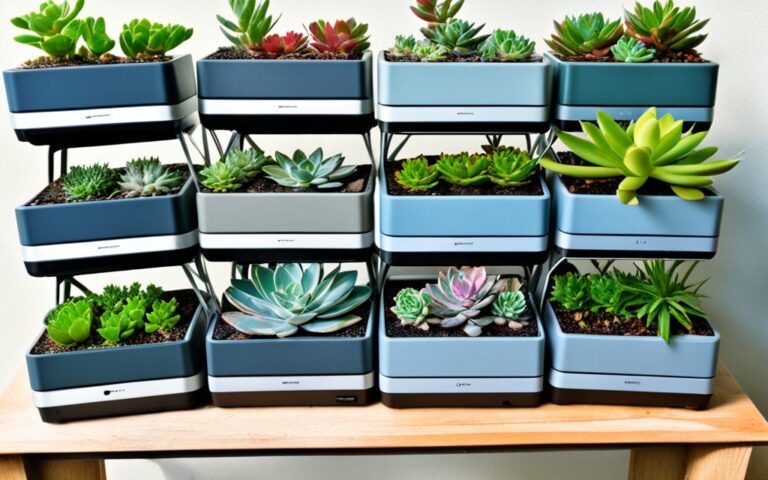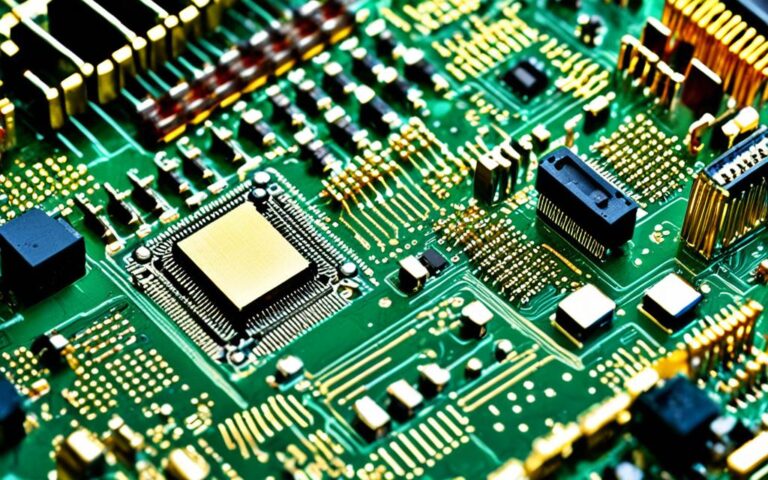More people own computer peripherals now than ever before. They have a wide range of devices like cameras, USB flash drives, tablets, laptops, and desktop computers (Source:1). This trend is happening all over the world.
The rise in threats is a big reason why people own more devices. Smartphones and tablets are easy targets because they’re small and can go anywhere (Source:1). It’s important for people to protect their devices well.
Groups like the FBI have strict rules for using personal devices with sensitive info (Source:1). They check devices to make sure they’re secure and follow the rules. This includes updates and antivirus software (Source:1).
Using public computers for sensitive info is not allowed (Source:1). If a device gets lost or stolen, it must be reported quickly to reduce risks (Source:1).
IT support is key in keeping devices safe. They make sure devices get the latest updates and security checks (Source:1). When devices are no longer used, they must be properly erased before being sold or repaired (Source:1).
In summary, owning computer peripherals is common and necessary for many tasks. But, it’s important to be careful and follow best practices to keep information safe and secure (Key Takeaways:
- Personal ownership of computer peripherals has seen significant growth worldwide (Source:1).
- Mobile handheld devices face specific threats due to their size and portability (Source:1).
- Strict policies and inspections are in place for personally owned devices accessing sensitive information (Source:1).
- Utilizing publicly accessible computers for sensitive information is prohibited (Source:1).
- Proper disposal and up-to-date security measures are crucial for personally owned devices (Source:1).
Key Takeaways
- Personal ownership of computer peripherals has seen significant growth worldwide (Source:1).
- Mobile handheld devices face specific threats due to their size and portability (Source:1).
- Strict policies and inspections are in place for personally owned devices accessing sensitive information (Source:1).
- Utilizing publicly accessible computers for sensitive information is prohibited (Source:1).
- Proper disposal and up-to-date security measures are crucial for personally owned devices (Source:1).
Smartphone Ownership
Smartphones have changed how we use technology and connect with others. Now, 68% of adults in the US own a smartphone2. This shows a big jump from 2011. Smartphones are now a big part of our daily lives.
Many people own smartphones, but some groups are less likely. Those over 65 and those without a high school diploma are less likely to own one2. Yet, more young people and those with higher incomes are getting smartphones3.
Smartphones are key for communication, work, and fun. They let us do lots of things, from browsing the internet to managing work tasks3. Keeping these devices safe and private is very important3.
“The rise of smartphones has transformed our way of life, allowing us to stay connected, informed, and empowered. We now carry the world’s knowledge and the ability to connect with anyone in our pockets. It’s a remarkable testament to human progress.”
Securing Personal Information
It’s key to keep your smartphone safe to protect your personal info. Use strong passwords for each account3. This keeps your data safe from hackers.
Smartphones are important for work too. To keep work info safe, use security tools like encryption and password protection3. This helps protect against risks when using mobile devices.
Also, be careful with work emails. Avoid sending them to many people at once3. This helps keep your work emails safe from unwanted eyes.
Reporting Unauthorized Telework
It’s important for companies to be open and follow rules. If someone takes work info home without permission, tell someone3. This helps keep everyone honest and safe.
Managing Alternative Mobile Devices
In places like the Department of Defense, using personal phones for work needs special rules4. You need approval before using your phone for work info4.
It’s important to follow rules when using personal phones for work4. These phones should be used by choice, not forced4. Make sure to keep everyone updated on phone use4.
When using personal phones for work, follow all the rules4. Using a special system to manage phone access helps keep work info safe4.
Special Note on Government-Related Sources:
For more info on government topics, check these sources:
- DISA_CAC2024_GovtFacilitiesResources
- Cyber Awareness Answers
- Use of Non-Government Owned Mobile Devices
Cellphone Ownership
Most American adults, 92%, own a cellphone5. This number has jumped from 65% in 20045. Cellphones are popular across many groups, but older people and those with lower incomes own them less. People living in rural areas also have lower rates of cellphone ownership5.
In places like Brazil and Russia, 80% of workers use their personal tech at work5. Surveys show that stopping employees from using personal devices at work is hard5. About 95% of workers use personal devices for work tasks5. In 2018, only 17% of companies gave all employees a mobile phone, while 31% didn’t give any and 52% used a mix of company and personal devices5.
In the Middle East, 80% of employees used their personal devices for work in 20125. The UK’s CIPD Employee Outlook Survey 2013 showed big differences in BYOD use across industries5. The education sector had the highest BYOD rate at 95.25%, according to Cisco partners5.
Research by Kyndryl found that 82% of employees see smartphones as crucial for work, offering benefits like better productivity and satisfaction5. An IDG survey showed over half of IT leaders faced serious issues with personal mobile device use5. Solutions include mobile device management, containerization, and app virtualization5.
| Demographic Group | Cellphone Ownership Percentage |
|---|---|
| Older Adults | Slightly Lower Ownership Rate |
| Lower-Income Individuals | Slightly Lower Ownership Rate |
| Rural Residents | Slightly Lower Ownership Rate |
| Urban and Suburban Residents | Higher Ownership Rate |
Cellphone ownership is widespread, with most American adults having a mobile device. Ownership rates vary slightly by group, but smartphones are key for work and personal life. With BYOD on the rise, companies must ensure data security. Using mobile device management and other tech can help protect data and benefit from cellphone use in the workplace5.
Tablet Ownership
Tablets have changed how we use digital content and interact with technology. Since 2010, the number of U.S. adults with a tablet has grown tenfold6. Now, about 45% of adults in the U.S. own a tablet. But, the growth has slowed down since 2014.
Who owns tablets shows some interesting trends. Younger adults are more likely to have them, showing their love for digital gadgets. They want to stay connected everywhere they go. Also, richer people are more likely to have tablets because they cost more.
How much education you have also matters. College graduates are more likely to own tablets. This is because tablets are seen as useful for work and learning.
Race and ethnicity also affect who owns tablets6. It’s important to look into why some groups have more tablets than others. We need to make sure everyone can get to use technology.
Tablets have changed many areas like education, entertainment, and business. They’re great for learning online, watching videos, and getting work done. As more people get tablets, we must make sure everyone can use them. This will help bridge the digital gap.
E-Reader Ownership
Since 2014, the number of adults owning e-readers like Kindles or Nooks has dropped to 19%7. This drop is due to smartphones and tablets becoming more popular. These devices offer e-reading and many other features. So, many people now prefer devices that do more than just read books.
Women, whites, and those with higher income and education levels are more likely to own e-readers7. But, e-reader use is not limited to any one group. It shows that anyone can enjoy reading on these devices.
The drop in e-reader use is also because e-reading tech has improved. Now, you can read e-books on smartphones and tablets7. These devices are versatile, making e-readers less necessary.
Even though fewer people own e-readers, more Americans are reading e-books, with 21% doing so in the past year7. This shows that digital reading is still popular, even without dedicated e-readers.
More people are reading more thanks to e-content, with 30% reading more since e-content became available7. E-books let readers access more books and long texts easily7. In fact, 42% of e-book readers read more now because of digital long-form content7.
Some readers prefer e-books for their quick access and portability7. But, print books are still chosen for reading to children or sharing with others7. This shows that both digital and print books have their own special places.
In summary, even though e-reader numbers are down, digital reading is still strong thanks to e-reading apps on mobile devices7. E-content’s convenience has changed how we read, showing the evolving book world in our digital times.
Computer Ownership
About 73% of U.S. adults own a computer8. This is true for college graduates, those with higher incomes, and younger people. Whites own computers more than Hispanics and blacks.
Computers are vital for work, learning, talking to others, and fun. They let people access lots of info, talk to people worldwide, and do online activities.
Having a computer means you can work or study from home or the office. It’s great for writing, researching, and making presentations. It’s a key tool in many fields like business, education, healthcare, and the arts.
Laptops are getting more popular because they’re easy to carry around. They let people work or study from anywhere. This is why students, remote workers, digital nomads, and travelers love them.
Who owns computers shows who has more access and chances. We need to make sure everyone can get to computers and tech, no matter their background or demographics. This helps people and communities use technology to its fullest.
With computers being used more, keeping them safe is key. Users should update their software, use strong passwords, and watch out for scams. Also, be careful with personal devices on government computers8. Only 30% of companies let personal devices on government computers, so it’s important to follow the rules.
Computer ownership is crucial today. It helps people stay connected, get information, and join the digital world. As tech changes, making sure everyone can access computers and keeping them safe is vital. This helps people and businesses use computers fully.
Game Console Ownership
Since 2010, about 40% of adults have owned a game console. This shows a steady interest in gaming devices among people9.
There are differences in who owns game consoles. Those with higher incomes and some college experience are more likely to have one. This shows that owning a game console depends on income, education, and social class9.
Young adults, of all genders and races, are more likely to own game consoles. This matches the idea that gaming is big with the young. They’ve grown up with technology and love gaming9.
Big names like Nintendo, Sony, and Microsoft lead the game console market. They keep coming out with new, popular gaming devices that grab people’s attention9.
The handheld market has dropped as mobile gaming grew. But Nintendo is still big in handheld gaming. They make consoles for a special group of gamers9.
The first home video game console came out in 1972, starting the gaming industry we see today. Handheld consoles started then too, with the Microvision being the first9.
Game consoles have changed every five years or so, with new generations. Each new one brings better technology and more realistic games9.
The gaming industry makes money mainly from game sales. Consoles are sold cheap or even at a loss. But the real profit comes from licensing fees for each game sold9.
There’s some debate over how to call console generations. Different models and views lead to different names for these generations. This can cause confusion between academic and industry views9.
Game Console Ownership Statistics
Here’s a table with sales figures for famous gaming consoles:
| Console | Units Sold | Decade |
|---|---|---|
| NES Family Computer | 62 million | 1980s10 |
| Sega Genesis | 35 million | 1980s10 |
| Super NES | 49 million | 1990s10 |
| Sony Playstation | 102 million | 1990s10 |
| Playstation 2 | 155 million | 2000s10 |
| Dreamcast | 9 million | 1990s10 |
| Nintendo 64 | 34 million | 1990s10 |
| 3DO Interactive Multiplayer | 2 million | 1990s10 |
| Sega CD | 2 million | 1990s10 |
These sales numbers show how popular and successful different gaming consoles have been over the years. They highlight the growing interest in owning game consoles10.
Portable Gaming Device Ownership
Portable gaming devices are now a big hit for those who love gaming and want fun on the move. In recent times, more people are getting these devices like smartphones and tablets. This shows how tech is changing and getting more varied11. These devices let users play games, watch videos, and work on the go in a small package.
A study found many people own these devices along with other gadgets, showing their growing popularity11. It also shows that many see these devices as key for fun and staying connected11.
About 14% of U.S. adults have a portable gaming device, like a PSP or Sega Genesis12. This is more common in households making $75,000 a year. It doesn’t matter much if you’re male or female, or what your race or ethnicity is12. This shows portable gaming devices are liked by many different people.
Research shows people like devices that can do many things, like play games, talk to friends, and watch videos11. This matches how we use these devices for gaming, watching shows, chatting on social media, and getting work done11.
Demographic Differences in Portable Gaming Device Ownership
There are big differences in who owns these devices. For example, 67% of 12-14-year-olds have them, but only 44% of 15-17-year-olds do12. Boys are more likely to own them than girls, with 61% to 49%12. These numbers show different groups have different interests in portable gaming.
| Demo | Ownership Percentage |
|---|---|
| Teenagers (12-14) | 67% |
| Teenagers (15-17) | 44% |
| Boys | 61% |
| Girls | 49% |
Table: Demographic Differences in Portable Gaming Device Ownership.
This table shows how different groups own these devices at different rates. It highlights the importance of looking at age and gender when studying these trends.
MP3 Player Ownership
In the United States, the number of people owning MP3 players has changed over time. By13, about 40% of U.S. adults had an iPod or another MP3 player. This shows a drop in their use compared to before. But, the rate of ownership changes with age.
Older people in the U.S. are less likely to have an MP3 player13. Younger people, however, use them more. This shows that the younger generation likes the ease and features of MP3 players more.
Studies from14 show a big jump in MP3 player use among American adults. In early 2005, only 11% owned one. By the study’s end, this number jumped to 47%. This rise shows how people’s tastes and habits have changed, with more choosing MP3 players for their music.
There’s no big difference in MP3 player use between men and women, or different races and ethnicities14. This means MP3 player use is pretty even across different groups. The main thing that affects it is age.
The drop in MP3 player use is mainly because of smartphones and tablets15. These devices can do many things, including play music. This has changed how people use MP3 players, making them less popular.
At first, South Korean startups led the MP3 player market15. Apple’s iPod was a big hit. MP3 players could hold up to 128 GB or 500 GB of music15. They also started playing more file types, like WMA and AAC, making them more versatile15.
Here’s a table showing how many American adults own different gadgets:
| Gadget | Ownership Rate (%) |
|---|---|
| Cell phone | 83 |
| MP3 player | 43 |
| Game console | 37 |
| Portable gaming device | 18 |
The table shows MP3 players are still very popular, even though their numbers are going down13.
Looking at the stats, we see MP3 player use has dropped. But, they still mean a lot to music lovers. Their ease, portability, and focus on music keep them popular in the changing world of portable devices.
Household Computer Ownership Worldwide
More homes worldwide now have a computer than in 2005. This shows how computers are becoming a common part of life. They help people and families do many things and stay connected. Let’s look at how owning a computer affects society.
Trends in Household Computer Ownership
Technology has changed a lot, changing how we use computers at home. From the first home computers to today’s all-in-one devices, they’re key for talking, working, learning, and fun. Knowing how many homes have computers helps us understand what people need and want globally.
In the late 70s and 80s, home computers were cheaper than those for businesses. This made them available to more people, increasing how many homes had them16. These early computers had a keyboard, a display, and could run games and apps. They used cassette tapes or floppy disks for saving data16.
Floppy disk drives made home computers better, making them more popular. Cassette drives were common but floppy disks were faster and held more data, making computers more useful16. Different models were made for various countries, making them easier to use everywhere16.
Companies like Acorn Computers and Apple made popular home computers. These included the Acorn Atom, BBC Micro, Apple II, and Apple Macintosh. They used processors like the Z80, 6502, and 68000, offering different levels of power for users16.
Other computers like the Commodore 64, ZX Spectrum, and Amiga also changed the market. They brought new features and technologies, making a mark in history and changing how we use computers at home16.
| Year | Percentage of Households with Computers |
|---|---|
| 2005 | 45% |
| 2010 | 57% |
| 2015 | 67% |
| 2019 | 75% |
The table shows how more homes are getting computers. In 2005, 45% had them, but by 2019, it was 75%16. This shows we’re using computers more in our lives. As technology gets better, we expect more homes to get computers, changing how we live and work.
“Computers are like paintbrushes or pens – a means of expression and communication in the digital age.” – Anonymous
Conclusion
More people are now owning gadgets like smartphones, tablets, and computers. This shows how technology is becoming a big part of our lives. People from all walks of life are using these devices to make their days better and have fun.
Who owns these gadgets matters too. Things like age, money, education, and race affect how people use technology. Knowing this helps companies make products that fit what different people want. This way, they can reach more people with their tech.
Studies show us how common it is for people to own these devices171819. It’s important to keep these gadgets safe from cyber threats, as attacks are becoming more common17. Also, these devices should work well all the time, being down for less than 10 minutes a month18.
In short, technology is a big deal in our lives today. We need to keep making it better and safer for everyone. By understanding who uses technology and how, we can make sure it improves our lives without causing problems.
FAQ
What are personally-owned computer peripherals?
These are devices that connect to a computer to make it work better or add new features. Examples include smartphones, tablets, e-readers, and MP3 players.
How has smartphone ownership changed over the years?
More people now own smartphones. In the US, 68% of adults have one, up from 2011. Most groups own them, except for those over 65 and those without a high school diploma.
What is the ownership rate of cellphones in the United States?
Almost all American adults, 92%, have a cellphone. This has jumped from 65% in 2004. It’s common across most groups, but less so among older and poorer people. City living also means more cellphone use.
What is the ownership rate of tablets among U.S. adults?
Tablet use has grown a lot, now 45% of adults own one. This rate has stayed steady since 2014. It’s more common among the young, wealthy, and educated.
How has e-reader ownership changed in recent years?
Fewer people own e-readers now, down to 19% of adults. They’re more common among women, whites, and those with more income and education. But there’s no big difference by gender or race.
What is the ownership rate of traditional computers?
Most U.S. adults, 73%, still own a computer. It’s more common among those with more education and income, and the young. Whites own them more than Hispanics and blacks.
What is the ownership rate of game consoles?
About 40% of adults have a game console. It’s more likely among those with higher incomes and some college. Young people own them more, regardless of gender or race.
What is the ownership rate of portable gaming devices?
14% of adults have a portable gaming device. It’s more common in richer households. There’s no big difference by education, gender, or race.
How many U.S. adults own an MP3 player?
Still, 40% of adults have an MP3 player. It’s less common among the elderly. There’s no big difference by gender or race.
How has household computer ownership changed globally?
More households worldwide have a computer now than in 2005. This shows computers are becoming more common globally.
What are the demographic variations in personal ownership of computer peripherals?
Who owns tech devices varies by age, income, education, and race. Younger people, those with more money, and college grads own more devices. This shows how technology is a big part of our lives and matters for different groups.
Source Links
- https://www.fbi.gov/file-repository/personally-owned-device-policy.pdf – PDF
- https://dl.dod.cyber.mil/wp-content/uploads/trn/online/disa-cac-2024/pdf/DISA_CAC2024_GovtFacilitiesResources.pdf – Cyber Awareness Challenge 2024 Government Facilities and Resources
- https://quizzma.com/cyber-awareness-answers/ – Cyber Awareness Challenge 2024 Answers » Quizzma
- https://dodcio.defense.gov/Portals/0/Documents/Library/UseOfNon-GovernmentOwnedMobileDevices.pdf – Memo on the Use of Non-Government Owned Mobile Devices
- https://en.wikipedia.org/wiki/Bring_your_own_device – Bring your own device
- https://dwayne-morise-5k9d.squarespace.com/cbts/2023/12/12/cyber-awareness-2024-questions-and-answers – Cyber Awareness 2024 Questions and Answers — I Hate CBT’s
- https://www.pewresearch.org/internet/2012/04/04/the-rise-of-e-reading-5/ – The rise of e-reading
- https://dl.dod.cyber.mil/wp-content/uploads/trn/online/disa_cac_2022_final_web/pdf/DISA_CAC2022_ComputerUse.pdf – Cyber Awareness Challenge 2022 Computer Use
- https://en.wikipedia.org/wiki/History_of_video_game_consoles – History of video game consoles
- https://hosatech.com/press-release/history-of-video-games/ – History of Gaming Setups – 80’s, 90’s & 00’s – Hosa
- https://dl.dod.cyber.mil/wp-content/uploads/trn/online/disa_cac_2022_final_web/pdf/DISA_CAC2022_RemovableMedia_MobileDevices.pdf – Cyber Awareness Challenge 2022 Removable Media and Mobile Devices
- https://www.pewresearch.org/internet/2009/08/19/teens-and-mobile-phones-over-the-past-five-years-pew-internet-looks-back/ – Teens and Mobile Phones Over the Past Five Years: Pew Internet Looks Back
- https://www.pewresearch.org/internet/2010/02/03/part-2-gadget-ownership-and-wireless-connectivity/ – Part 2: Gadget ownership and wireless connectivity
- https://www.pewresearch.org/internet/2010/10/14/americans-and-their-gadgets/ – Americans and their gadgets
- https://en.wikipedia.org/wiki/Portable_media_player – Portable media player
- https://en.wikipedia.org/wiki/List_of_home_computers – List of home computers
- https://www.cdse.edu/Portals/124/Documents/student-guides/CS130-guide.pdf?ver=00gYkCPZlAzxAVjUFdDQ5Q== – Student Guide for CyberSecurity Awareness
- https://nap.nationalacademies.org/read/1581/chapter/4 – Concepts of Information Security | Computers at Risk: Safe Computing in the Information Age
- https://www.cisa.gov/sites/default/files/publications/RisksOfPortableDevices.pdf – PDF


















